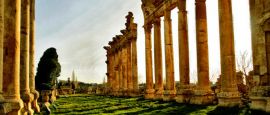Lebanon History, Language and Culture
History of Lebanon
Lebanon’s advantageous geographical location on the edge of the Mediterranean and at the crossroads between Europe and the Middle East has shaped its historical, cultural and political identity. The earliest evidence of civilisation in Lebanon dates back more than 7000 years and the area was a stronghold of the powerful seafaring Phoenicians who founded important coastal trading ports like Tyre, Tripoli and Byblos.
The Turks took control of the area in the 16th century during the major expansion of the Ottoman Empire and remained there until the end of World War 1. Lebanon was created in its present boundaries in 1920 under the French Mandate, which administered the country until Lebanon gained independence and became a republic in 1943.
For several decades Lebanon’s diverse religious groups existed in relative harmony and the country developed a thriving economy, while Beirut became one of the most visited cities in the Mediterranean.
However, in the early 1970s large numbers of PLO (Palestine Liberation Organization) fighters expelled from Jordan sought refuge in Lebanon, which in 1975 led to civil war with Beirut split across the Green Line, dividing the Christian-dominated east and the Muslim west.
In 1982 the presence of the PLO led to an Israeli invasion of Lebanon and although they retreated to a self-declared security zone in the south there followed an intense guerrilla war with Hezbollah that continued despite the peacekeeping efforts of the international community.
Peace returned to most of Lebanon in 1990, although fighting continued between Israel and Shia militia in the south until Israeli occupation ended a decade later. With a more stable political environment, the lengthy process of rebuilding Beirut began in earnest and the country seemed poised to make a comeback until the assassination on 14 February 2005 of former Prime Minister Rafic Hariri in a bomb attack in Beirut.
Since 2006 Lebanon has been embroiled political crisis. A major conflict erupted between Lebanon and Israel, which resulted in heavy fighting and large-scale loss of life on both sides of the border. A ceasefire finally came into place, following intervention from the UN Security Council.
In 2009 Rafiq Hariri’s son, Saad Hariri was elected prime minister and formed a national unity government, but the relative stability that ensued did not last and in January 2011 the government collapsed. A new government led by Najib Mikati was formed in June.
Did you know?
• In the 1960s Lebanon was known as the ‘Switzerland of the East’.
• Next to Israel, Lebanon is the largest recipient of US military aid per head of population.
• Several Lebanese writers have achieved international success, most notably Khalil Gibran whose 1923 book The Prophet is a modern classic.
Lebanon Culture
There are 18 registered sects in Lebanon with Islam and Christianity the main religions. Islam (predominantly Shi'ite) accounts for approximately 59.7% of the population's beliefs, while Christian denominations, mainly Greek Orthodox, Maronite, Armenian and Protestant, account for a further 39%.




 You know where
You know where